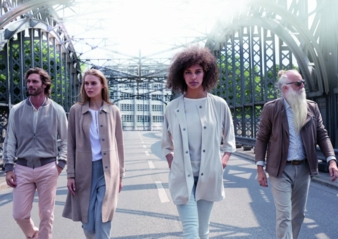02/10/2017 – 131 years Gerecke Leder — auf Deutsch lesen
Fashion leather goods using sustainable tanning processes
What was once a tawery, founded in 1886 by Martin Christian Gerecke, is today a modern leather factory with a diverse product range.
Located in Esslingen, in the south German state of Baden-Württemberg, the company now in its 4th generation continues its successful progress under the management of Gunther Gerecke, following the time-honoured dictum, “Gerecke - always testing the waters.”
This is true at many levels, not least given that Gerecke’s site lies, as it always has, on the banks of the Neckar river. At the same time, the family’s long chronicle reflects clearly both the high points of the once strong German tanning industry and its decline. Setbacks due to political turmoil, including a temporary shutdown by the Reich Ministry for the Economy and the loss of potential American customers caused by Black Friday, are part of family and company history at Gerecke Leder GmbH & Co. Alongside the fresh starts that these required, the company has also had to master ever-increasing environmental regulation and massive technical changes such as new tanning and dyeing technologies.
Leather, a brand from nature
The tanning expertise gathered by Gerecke over the generations is still employed today in top quality hide processing. Surviving in an expensive location such as Germany depends solely on the ability to supply the highest level of quality, with no compromises.
All of the demands of strict environmental protection legislation are met, requiring a high level of investment. Since leather production requires large quantities of water, responsible use of this resource is very important. All waste water produced is purified in the company’s own wastewater treatment plant. Pollutants are filtered out of the waste water by chemical as well as mechanical means. In recent years, various process modifications have significantly reduced water consumption. The in-house treatment plant meets all of the waste water regulations, including for example the limit of 1 mg of chromium per litre. A separate storage facility for water-polluting substances is available.
Hides from small animals, deer and even peccary are prepared by 15 well trained staff for shoes, clothing and gloves (for use in motorsport and riding). One particular speciality is washable and dry-cleanable lamb nappa leather that can readily be combined with textiles. The strict quality criteria demanded by public authorities and the military are met with goat nappa leather for gloves and shoes. A highlight of the product range is the smooth leather of the North American white-tailed deer. All colours can be supplied, with maximum authenticity: azo dyes are not used. Top of the range raw hides are processed into soft aniline leathers in brilliant, expressive colours.
A love of the natural product
A love of the natural product, the utmost skill in tanning and not least the resilience to overcome crises have been and continue to be the major capital that has shaped the Gerecke family business for generations. In the leather industry, Germany continues to be a pioneering market. Since exports have always been a powerful force for Gerecke leather, they are regarded as an integral element of growth and of the future. Meeting all of the quality criteria that underlie the high demands of the global market is a sine qua non for the company and an inherited company philosophy.
Read more about Gerecke Leather by Sonja Langer-Korsch in the printed issue textile network 9-10 2017 (be published 22th August 2017)





